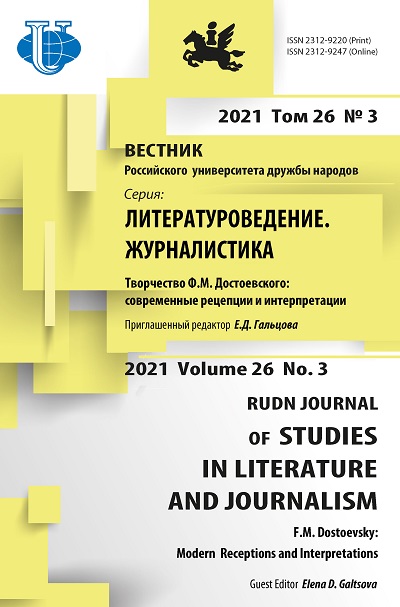Dostoevsky in Kazakhstan: History of Study, Results, Prospects
- Authors: Matyzhanov K.S.1, Ananyeva S.V.1
-
Affiliations:
- Institute of Literature and Art named after M.O. Auezov, Ministry of Education and Science of the Republic of Kazakhstan
- Issue: Vol 26, No 3 (2021): F.M. DOSTOEVSKY: MODERN RECEPTIONS AND INTERPRETATIONS
- Pages: 414-423
- Section: LITERARY CRITICISM
- URL: https://journals.rudn.ru/literary-criticism/article/view/27643
- DOI: https://doi.org/10.22363/2312-9220-2021-26-3-414-423
Cite item
Full Text
Abstract
The article is devoted to the analysis of the Semipalatinsk and Kuznetsk periods in the life and work of F.M. Dostoevsky. The purpose of the study is to reveal the Kazakh-Siberian periods in the fate of the Russian writer, their reflection in the letters and works of art by F.M. Dostoevsky. In the year of the 200th anniversary of the birth of the Russian writer, we cannot talk about the complete study of the indicated periods of the life of the prose writer, which, of course, to one degree or another, were reflected in his prose. This determines the degree of novelty of this article. Dostoevsky is dear to Kazakhstan. He not only served his exile, but also found a friend here, sincere and quivering - the historian, orientalist, ethnographer Ch. Valikhanov. The stories “Uncle's Dream” and “The Village of Stepanchikovo and Its Inhabitant”, the first chapters of Notes from the Dead House were written in Semipalatinsk. The story “The village of Stepanchikovo and its inhabitants” (1857-1859) has the author's clarification: “From the notes of the unknown”. Many works of fiction in world literature are the result of travel notes, diaries. Undoubtedly, the restoration of the history of the Kazakh-Siberian period of the life and work of F.M. Dostoevsky is of great value, because the greatest Russian writer experienced spiritual revival there, in Kazahstan. The works of F.M. Dostoevsky were included in the literature program of secondary schools in Kazakhstan, translated into Kazakh ( The Idiot, The Brothers Karamazov translated by N. Syzdykov). Dostoevsky scholars of Kazakhstan in the XXI century continue to study the writer’s works.
Keywords
About the authors
Kenzhekhan Slyamzhanovich Matyzhanov
Institute of Literature and Art named after M.O. Auezov, Ministry of Education and Science of the Republic of Kazakhstan
Author for correspondence.
Email: kmatyzhanov@gmail.com
ORCID iD: 0000-0002-7016-0304
Doctor of Philology, General Director
29 Kurmangazy, Almaty, 005010, Republic of KazakhstanSvetlana V. Ananyeva
Institute of Literature and Art named after M.O. Auezov, Ministry of Education and Science of the Republic of Kazakhstan
Email: svananyeva@gmail.com
ORCID iD: 0000-0001-7349-1590
Candidate of Sciences (Philology), Associate Professor, Head of the Department of International Literary Relations and World Literature
29 Kurmangazy, Almaty, 005010, Republic of KazakhstanReferences
- Levchenko, N.I. (1989). The circle of Semipalatinsk acquaintances F.M. Dostoevsky (1854–1859). In Dostoevsky and the Present. Materials of Dostoevsky readings. Semipalatinsk. (In Russ.)
- Dostoyevskiy, A.D. (2004). A Word about Dostoevsky. In Dostoevsky and World Culture: Fictional Heritage and Spirituality (p. 7). Semipalatinsk. (In Russ.)
- Ashimbayeva, N. (2005). The world of Dickens as reflected in the works of Dostoevsky. In Ashimbayeva, N. Dostoyevskiy. The context of fiction and time (pp. 46–55). Saint-Peters-burg: Serebrianyi vek Publ. (In Russ.)
- Kushnikova, M.M. (1992). The Dark Man of the Writer Dostoevsky (Riddles and Interpretations). Novokuznetsk: Kuznetskaia krepost’ Publ. (In Russ.)
- Kushnikova, M., Tillo, K., & Togulev, V. (2005). “The Kuznetsk crown” by Fyodor Dostoevsky in his novels, letters and bibliographic sources of the past century. (Book 1). Kemerovo: Kuzbassvuzizdat Publ. (In Russ.)
- Lvov, V. (2006). Talking about the personality of F.М. Dostoevsky. In Voices of Siberia. Second edition (pp. 601–609). Kemerovo: Kuzbassvuzizdat Publ. (In Russ.)
- Ananyeva, S.V. (2013). Research of Dostoevsky’s work in Kazakhstan. In Dostoevsky. Materials and research. (Vol. 20, pp. 286–292). Saint-Petersburg: Nestor-Istoriia Publ. (In Russ.)
















